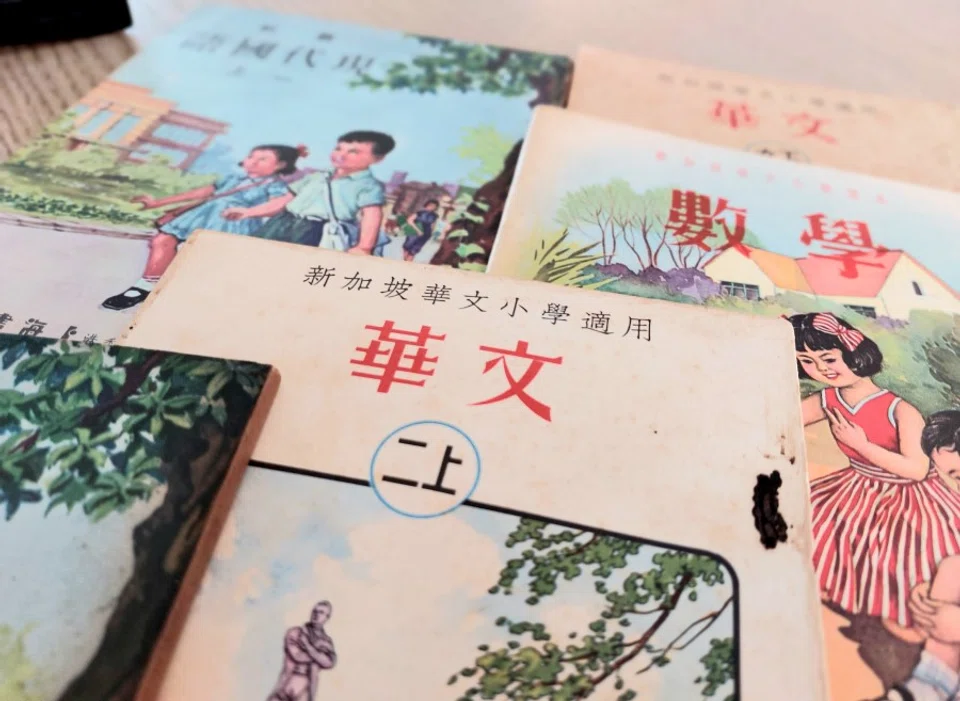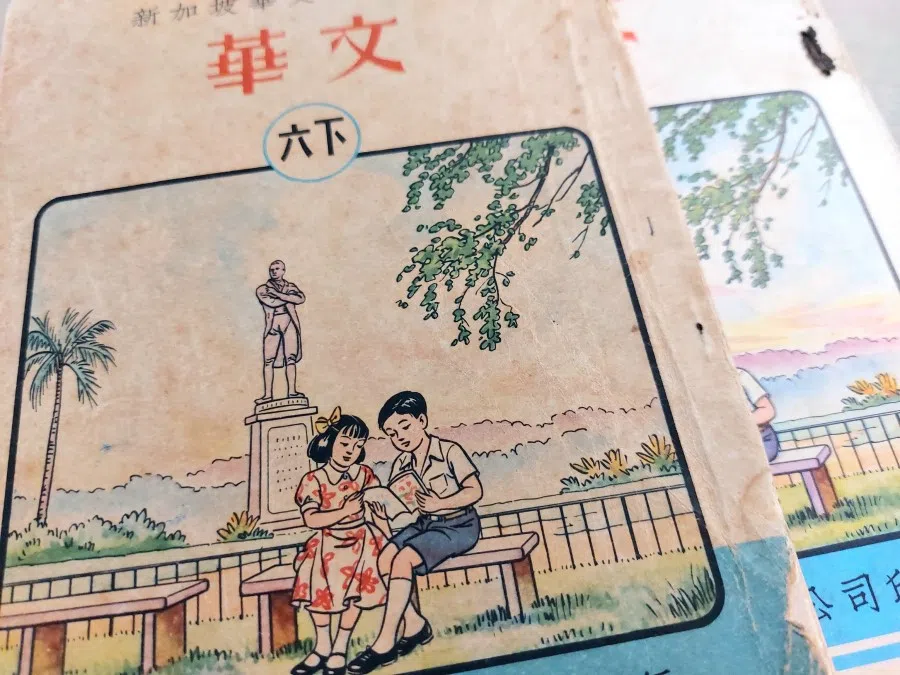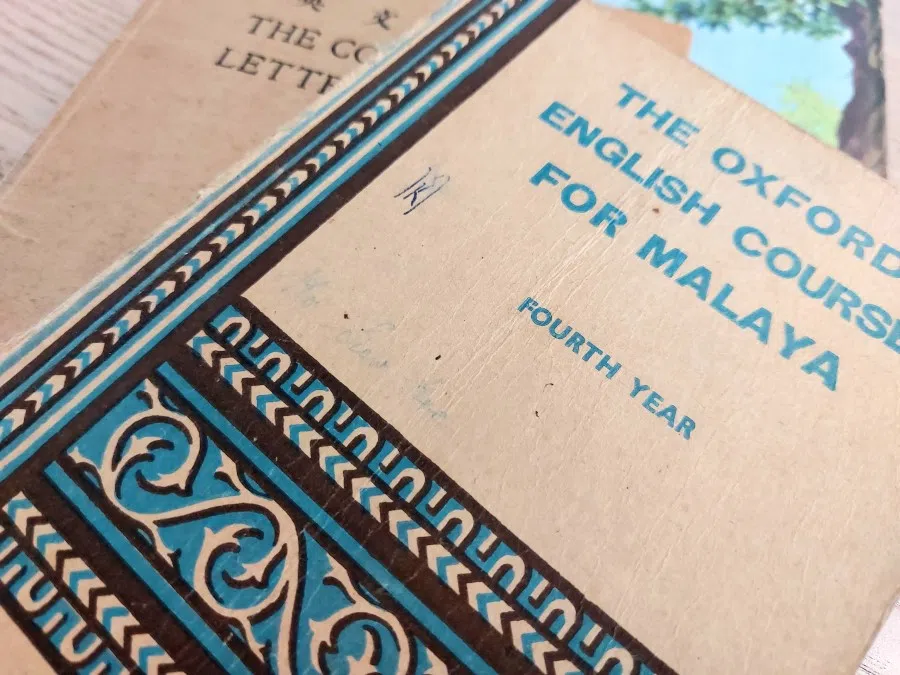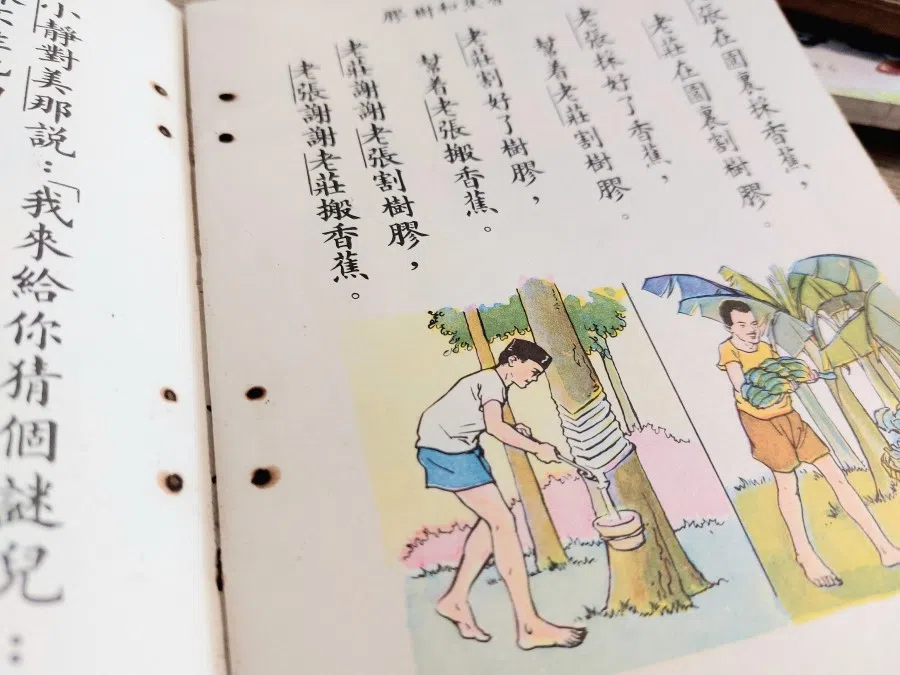What old Chinese textbooks say about life and times in Singapore
Former journalist Lim Jen Erh gets nostalgic about the Chinese textbooks he used growing up in Singapore. He remembers the illustrations depicting daily life in the 1960s and 1970s, not to mention historical events and the larger social milieu. In fact, the textbooks are not only a window into times past but a peek into the minds of those who wrote and studied them.

(All photos courtesy of the writer unless otherwise stated.)
Some years ago, I was in a little stationery store in Sydney's Chinatown. It's actually hard to say what kind of store it was as it sold everything - newspapers and magazines and miscellaneous goods, with a mini-fridge of drinks and shelves of books written in Chinese. Each time I was in Chinatown, I'd go in and walk around.
Once, among the pile of books, I found two primary school textbooks: Latest Modern Chinese Language (《最新现代国语》), 1A and 1B. The typeface and illustrations on the cover reminded me of my textbooks from primary school. There was a lesson that went: "Big brother is big, little brother is little..." It was all so familiar.
I wanted to buy it for nostalgia's sake but I hesitated. This was the Hong Kong edition from the 1960s - was it the same textbooks that we had read? After looking at it many times, I finally decided to buy it.

I'm reminded of this piece of history because a friend gifted me a copy of Chinese Language 6B《华文(六下)》, a textbook published in the 1960s. On the cover, it says: "Suitable for Chinese-medium primary schools in Singapore". The Primary 6 textbook contains few illustrations, unlike the Primary 1 Latest Modern Chinese Language textbooks, with large pictures on every page.
Seeing the world through our textbooks
The cover of Chinese Language 6B shows two primary school students sitting on a bench, reading a Chinese language textbook together. The boy is in a white shirt and blue shorts, and the girl is wearing a dress with red flowers on it; she has short hair and bangs, and a ribbon in her hair. They are under a tree in what looks like a park, with a low wall behind them; amid the greenery, there's a coconut tree and the statue of Sir Stamford Raffles with his arms crossed.
... the text calls Raffles a "friend of the Chinese", and says that he "valued, loved and cared for the Chinese". Reading it now, this seems a little pointless and strange.
Lesson 17, about "Remembering Raffles", opens with the governor unveiling the statue of Raffles at the plaza along Connaught Drive in 1887 - in 1919, during the 100th anniversary of the founding of Singapore, the statue was moved in front of the Victoria Memorial Hall.

The textbook does not mention that during the Japanese occupation, the statue was moved to the museum. It is said that the Japanese army had planned to melt it down as military resources, but for some reason stayed their hand. In 1946, after the war, the statue was returned to Empress Place. Interestingly, the text calls Raffles a "friend of the Chinese", and says that he "valued, loved and cared for the Chinese". Reading it now, this seems a little pointless and strange.
As it happens, The Oxford English Course for Malaya《马来亚的牛津英文课本(四年级)》from the 1950s also includes a lesson on Raffles, that says: "In almost every part of Malaya we remember some white men or women who came to live in our country, far from their own homes, to help people who needed their help." One of them was Raffles.
"Textbooks are like military beachheads - capture them, and victory is in sight." - Writer and Hua Language Centre director Chew Wee Kai
Capturing a time in history
That's how interesting old textbooks are. In an article titled "Textbooks for Chinese-Medium Schools: A Century of Tribulation"(《华校教科书百年沧桑》), writer and Hua Language Centre director Chew Wee Kai says: "Textbooks are like military beachheads - capture them, and victory is in sight. Every person in power actively takes control of textbooks to change the perceptions of the new generation, starting with education. With time, the effects are seen. As time goes by, many things seem to have passed on without a trace, but the fragments and glimpses quietly captured in textbooks preserve the political traces of a period, a time in history."
In Chinese Language 6B, the lessons before and after Raffles are on the "Majestic Stadium Merdeka", and "A Report on the General Election in Malaya". The former is a write-up on the Stadium Merdeka in Kuala Lumpur, describing it as "a symbol of the Malayan people's glorious victory. This stadium was completed the day before the Malayan Federation was established." The latter says that in 1955, "the Malayan people exercised their newly gained voting rights and chose the first autonomous government in Malaya's history".

Politics aside, the lessons also reflect the social realities, economic situation and personal relationships of the time.
For example, one lesson in Chinese Language 6B on functional writing was about a share withdrawal announcement. At the time, there were very few limited companies in Singapore - most were sole proprietorships or partnerships, and it was common for partners to have different views after a time and find themselves unable to work together. If someone wanted to withdraw their shares, they had to publish a declaration in the newspapers, for it to have a legal basis.
Then there was learning to write notices offering and seeking employment. The lesson says life was simple in the past, and job seekers or employers could ask family and friends for help. "Now, society is complex, people are busy and they live far apart. If one approaches relatives and friends for everything, no one would have the patience for that."
And the sample for the notice seeking employment goes like this: "I am a 16-year-old with a primary school education. My family is poor and I cannot continue with my studies. I am looking for a job in Singapore, such as newspaper proofreading, a shop assistant, odd jobs with a bank, or other work."
Places like Taiping Lake, Cameron Highlands, Batu Caves and Kek Lok Si Temple were probably popular holiday spots in the 1960s and 1970s.
A record book of life and times
Another textbook - similarly titled Chinese 6B (《华语》), published in 1974 - does not include functional writing. It is also a Primary 6 textbook, but the ten-year gap means that the experiences of children about to move up from primary school look very different.
The first lesson of Chinese 6B is Youth Day: "The opening ceremony of Youth Day was always held at the Jalan Besar Stadium, until the National Stadium was completed in 1973, when the opening was held there for the first time." (The National Stadium is now gone, and today's primary school students may not know it ever existed.)
The other lessons include adaptations of classic stories, and write-ups on Seletar Reservoir, the Olympics, as well as Taiping Lake and Bukit Larut in Perak, Malaysia. Incidentally, I took a look at the National Library's digital archives, and the old Chinese Language 6A also has a lesson on "Taiping Lake and Bukit Larut". Places like Taiping Lake, Cameron Highlands, Batu Caves and Kek Lok Si Temple were probably popular holiday spots in the 1960s and 1970s.

The biggest difference between the books of these two eras is that the earlier ones use traditional Chinese characters and the later ones use simplified characters. What they have in common is the use of phonetic transliteration. In 1973, the Ministry of Education started using hanyu pinyin, starting with lower primary, and so these upper primary textbooks were not yet affected, as they were published in 1974.
...there are the parents and children, and many illustrations are of family life... Were the children of that time familiar with such a middle-class scene?
Going back to those two Latest Modern Chinese Language textbooks, the lessons include lines like "Mummy rears chickens. Mummy asks elder sister to get some rice. Elder sister calls the chicks to come and eat the rice"; and "O moon, o moon, a little sickle. What are you doing, hanging there? Come down, come down."
Even back then, the children might not have reared chickens at home, and they might not have had a sickle hanging around, but they would have been familiar with village life. Subsequently, these were rarely seen in textbooks.
But I am more curious about something else. In Latest Modern Chinese Language, there are the parents and children, and many illustrations are of family life - sofa set and coffee table, book cabinets, pictures on walls and a cloth on the table, with the father in a Western suit and the mother in a qipao. Were the children of that time familiar with such a middle-class scene?
Related: My secret manuals of life | My childhood days in Xiamen Street, Taiwan: Of invisible warriors, string puppets and spring pancakes | US academic: Learning Chinese is another political battleground for China and the US | Memories of South China: The enchanting garden that Whampoa built in Singapore

![[Big read] Paying for pleasure: Chinese women indulge in handsome male hosts](https://cassette.sphdigital.com.sg/image/thinkchina/c2cf352c4d2ed7e9531e3525a2bd965a52dc4e85ccc026bc16515baab02389ab)


![[Big read] How UOB’s Wee Ee Cheong masters the long game](https://cassette.sphdigital.com.sg/image/thinkchina/1da0b19a41e4358790304b9f3e83f9596de84096a490ca05b36f58134ae9e8f1)
